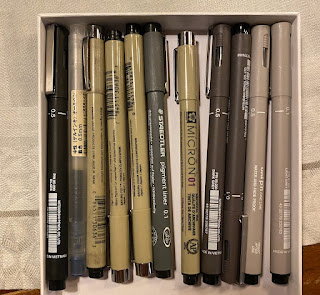°
After all these years on the island we finally stepped in to the
MUSEU FUNDACIÓN JUAN MARCH.
The museum is located totally in the city center,
in the busiest shopping area, pedestrian area,
kind of area where people interested in art exhibitions
do not necessarily walk through looking for museums. Hm.
In the aula there is this thing hanging. Pretty cool. Promising.
We went in and found many cool art works.
Here a few pics, favourites, maybe.
The museum has great large rooms which are not stuffed
full of artworks, on the contrary, there is enough
space to concentrate on each work.
In the background a picture painted by Salvador Dalí.
No wonder there are security doors between some rooms.
Eduardo Chillida: Elogio del hierro, 1956.
Finnisch für Anfänger:
RAUTA = Eisen / iron / hierro
Joan Ponç: Personnage du chat, 1952.
Check the fine lines, zentangling was alive already in the 50ies.
Das Zentangle
(von Zen bzw. Zen-Meditation und engl. tangle: Knäuel, Gewirr, Durcheinander)
ist eine freie Zeichnung, die aus Formen mit immer wiederkehrenden Mustern
aus einer Kombination von Punkten, Linien, einfachen Kurven und Kreisen
strukturiert ist.
Der meditative Vorgang des Zeichnens ist vorrangig und folgt einer eigenen Philosophie.
Das Zeichnen ist absichtslos und es gibt keine konkreten Vorstellungen von einem
bestimmten Ergebnis. Vielmehr wird der Intuition gestattet, sich zu entfalten.
(Wikipedia)
Did I just reveal my method of meditation ...?
Additionally you can call gardening meditation as well.
But I truly love these pens, this is my holiday home collection.
Zentangling everything, like this bad colored photo print.
OMG the Americans know it better:
As you use the Zentangle Method to create beautiful images,
you likely will enjoy increased focus, creativity, self-confidence
and an increased sense well-being.
And they also absolutely know how to make business with zentangle as well.
Lucio Muñoz: La ventana, 1963. 240 x 189 cm.
José Luis Gómez Perales: Construcción en dos planos, 1988.
Yes, construction on two plains. Not just painted.
This Barceló, Miquel, comes from Felanitx, from this island.
Equipo Crónica (Rafael Solbes & Manuel Valdés): La salida, 1968.
Sculpture by Manuel Valdés: Matisse como pretexto, 1988.
These guys greet you at the entrance.
Juan Bordes: Oradores I, II, III, IV, V, 1987-1989.
Die fünf Büsten der Serie Oradores stellen einen Höhepunkt im Schaffen
des Künstlers dar. Sie waren erstmals in einer seiner wichtigsten
Ausstellungen zu sehen, die 1990 mit dem Titel Cabezas muy españolas
in der Galería Estampa in Madrid stattfand. (Katalog S. 194)
This entrance situation is so typical for the old grand houses
in Palma. Often there is an open courtyard with plants.
Go and visit this museum, quick and dirty. And free.
Or check the internet page, it's pretty informative.
But ... I could not find the English version, so sorry.
But there is Wikipedia info about Mr. Juan March.
Juan Alberto March Ordinas (4 October 1880 – 10 March 1962)
was a Spanish business magnate, arms and tobacco smuggler,
banker and philanthropist.
After your visit I can tell you in which bakery you can buy these!

















1 kommentti:
Tämähän ei ole se museo, minkä ympärillä me pyörittiin eikä löydetty?
-Mur
Manolo Valdesin muistan "Las Meninas"-patsaista Espalla Helsingin Juhlaviikoilla 2007. Yks parhaista HKT:n kesistä.
Lähetä kommentti